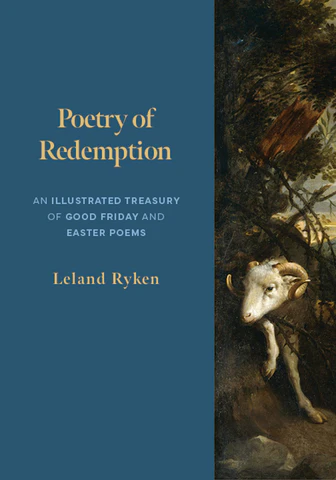
Leland Ryken
Reviewed by: Jonathan L. Cruse
Poetry of Redemption: An Illustrated Treasury of Good Friday and Easter Poems, edited by Leland Ryken. P&R, 2023. Paperback, 168 pages, $11.70. Reviewed by OP pastor Jonathan L. Cruse.
Dr. Leland Ryken, through his decades of teaching and writing, has established himself as an authority on the subjects of English literature and poetry. In Poetry of Redemption, he now brings his expertise to guide us through the wonderful poetic works that focus on the suffering, death, and resurrection of our Savior. Christian readers will recognize a number of the poems that have come to us in the form of some of our most beloved hymns, like “All Glory, Laud and Honor,” or “Alas! and Did My Savior Bleed.” Less familiar, perhaps, would be the non-hymnic poems of Edmund Spenser, Joseph Addison, George Herbert, and John Donne.
To introduce us to these great pieces, Ryken appends his historical, literary, and theological reflections to each, giving us a better understanding of these poems. One representative example is Herbert’s piece “The Agony,” which sets out to define two concepts: sin and love.
Who would know Sin, let him repair
Unto mount Olivet; there shall he see
A man so wrung with pains, that all his hair,
His skin, his garments bloody be.
Sin is that press and vice, which forceth pain
To hunt his cruel food through every vein.
Ryken explains, “The bulk of the stanza makes us feel the pain that Christ experienced in the garden of Gethsemane. . . . To make his pain vivid, Herbert employs imagery of machines (press and vice) that squeeze juice out of plants to portray the extreme mutilation of Jesus’ body.” If this is what sin looks like, where do we see love? “Given the poem’s title, we are inclined to say, ‘In Christ’s suffering and death.’ But the poem surprises us by answering, ‘In the Communion cup.’” Ryken refers to Herbert’s breathtaking conclusion:
Love is that liquor sweet and most divine,
Which my God feels as blood; but I as wine.
The poem “paints a picture of divine leniency: Christ shed his blood in agony, while we partake of the Lord’s Supper in the comfort of a church” (64–66).
Quite unique to other similar books by Ryken is that this is an illustrated collection—nearly every page is adorned with beautiful artwork, both classic and contemporary. This reviewer appreciated the publisher’s sensitivity to second commandment convictions in that, in a book filled with art related to Holy Week, there are no explicit images of Jesus. This isn’t immediately evident. Opposite the introductory page, unless you know the original piece, you might not realize the man hanging on the cross is the thief, not Christ. Elsewhere, a page is laid out in such a way that in a fourteenth-century rendering of the Last Supper only the disciples are in frame. This thoughtful editing and design, embellishing the exquisite poetry and Ryken’s rich insights, results in a gorgeous book that many Christians would benefit to keep out on the coffee table or incorporate into family worship in the weeks leading up to Easter.
Click here for a second review of this book by Mark A. Green.
December 28, 2025
December 21, 2025
December 14, 2025
December 07, 2025
November 30, 2025
November 23, 2025
November 16, 2025
© 2026 The Orthodox Presbyterian Church